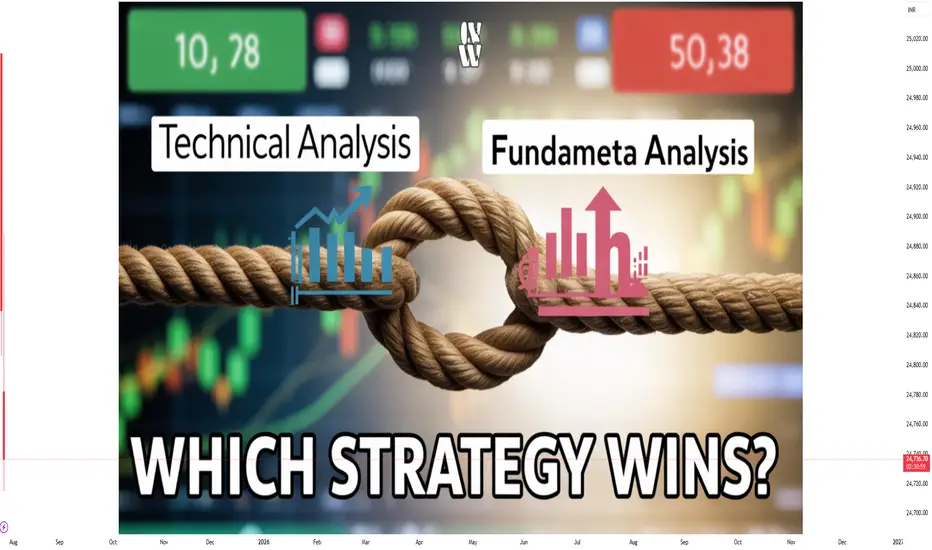What is Technical Analysis?
Technical Analysis involves studying historical price charts, volume data, and market indicators to forecast future price movements. It operates on the belief that "price reflects all known information." Hence, instead of looking at a company's balance sheet, a technical analyst focuses on patterns, trends, and momentum.
🔹 Key Principles of Technical Analysis
Market Discounts Everything: All news, earnings, and fundamentals are already reflected in the price.
Price Moves in Trends: Markets move in trends – uptrend, downtrend, or sideways – and tend to persist over time.
History Repeats Itself: Human behavior in markets follows patterns that tend to repeat, which technical analysis aims to exploit.
Strengths of Technical Analysis
Ideal for short-term traders and scalpers.
Uses real-time data, not delayed financial reports.
Visual, intuitive, and good for identifying precise entry/exit levels.
Applies universally across asset classes.
What is Fundamental Analysis?
Fundamental Analysis seeks to evaluate the intrinsic value of a security by analyzing financial statements, economic factors, industry conditions, and management performance. It’s more common among long-term investors, like Warren Buffett, who believe in buying undervalued stocks and holding them for years.
🔹 Key Principles of Fundamental Analysis
Every stock has an intrinsic value – a “true” value based on fundamentals.
The market may misprice stocks temporarily – creating opportunities.
Strong financials lead to long-term success – even if the short-term market fluctuates.
Strengths of Fundamental Analysis
Helps identify long-term investment opportunities.
Less volatile and emotional than technical trading.
Supports strategic investing based on actual business performance.
Useful for determining the true value of a stock.
Technical Analysis involves studying historical price charts, volume data, and market indicators to forecast future price movements. It operates on the belief that "price reflects all known information." Hence, instead of looking at a company's balance sheet, a technical analyst focuses on patterns, trends, and momentum.
🔹 Key Principles of Technical Analysis
Market Discounts Everything: All news, earnings, and fundamentals are already reflected in the price.
Price Moves in Trends: Markets move in trends – uptrend, downtrend, or sideways – and tend to persist over time.
History Repeats Itself: Human behavior in markets follows patterns that tend to repeat, which technical analysis aims to exploit.
Strengths of Technical Analysis
Ideal for short-term traders and scalpers.
Uses real-time data, not delayed financial reports.
Visual, intuitive, and good for identifying precise entry/exit levels.
Applies universally across asset classes.
What is Fundamental Analysis?
Fundamental Analysis seeks to evaluate the intrinsic value of a security by analyzing financial statements, economic factors, industry conditions, and management performance. It’s more common among long-term investors, like Warren Buffett, who believe in buying undervalued stocks and holding them for years.
🔹 Key Principles of Fundamental Analysis
Every stock has an intrinsic value – a “true” value based on fundamentals.
The market may misprice stocks temporarily – creating opportunities.
Strong financials lead to long-term success – even if the short-term market fluctuates.
Strengths of Fundamental Analysis
Helps identify long-term investment opportunities.
Less volatile and emotional than technical trading.
Supports strategic investing based on actual business performance.
Useful for determining the true value of a stock.
Hello Guys ..
WhatsApp link- wa.link/d997q0
Email - techncialexpress@gmail.com ...
Script Coder/Trader//Investor from India. Drop a comment or DM if you have any questions! Let’s grow together!
WhatsApp link- wa.link/d997q0
Email - techncialexpress@gmail.com ...
Script Coder/Trader//Investor from India. Drop a comment or DM if you have any questions! Let’s grow together!
Related publications
Disclaimer
The information and publications are not meant to be, and do not constitute, financial, investment, trading, or other types of advice or recommendations supplied or endorsed by TradingView. Read more in the Terms of Use.
Hello Guys ..
WhatsApp link- wa.link/d997q0
Email - techncialexpress@gmail.com ...
Script Coder/Trader//Investor from India. Drop a comment or DM if you have any questions! Let’s grow together!
WhatsApp link- wa.link/d997q0
Email - techncialexpress@gmail.com ...
Script Coder/Trader//Investor from India. Drop a comment or DM if you have any questions! Let’s grow together!
Related publications
Disclaimer
The information and publications are not meant to be, and do not constitute, financial, investment, trading, or other types of advice or recommendations supplied or endorsed by TradingView. Read more in the Terms of Use.
